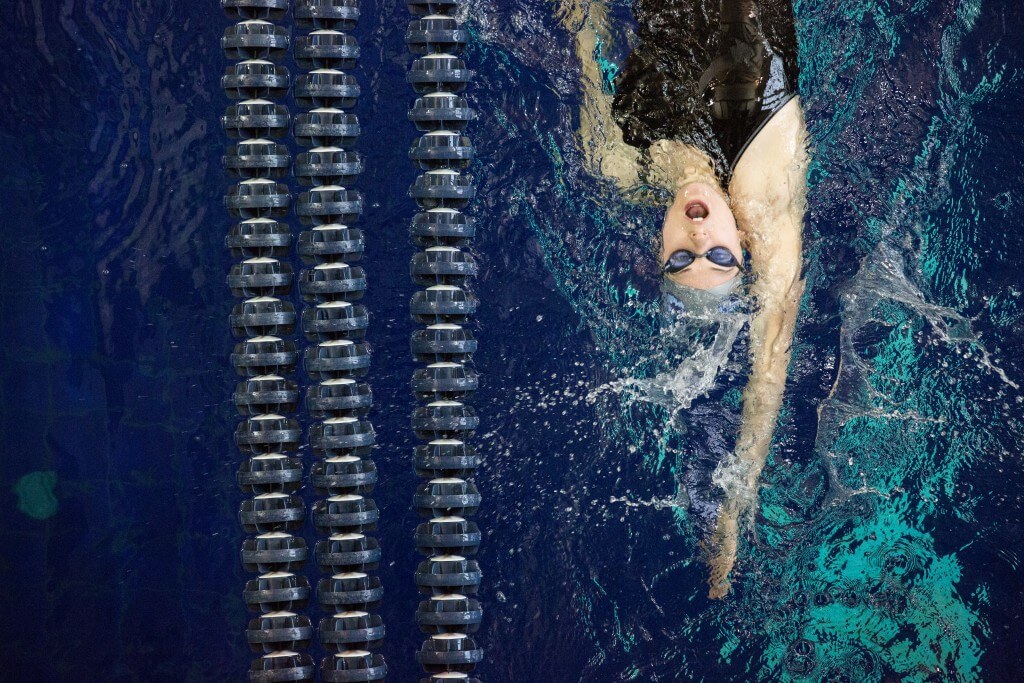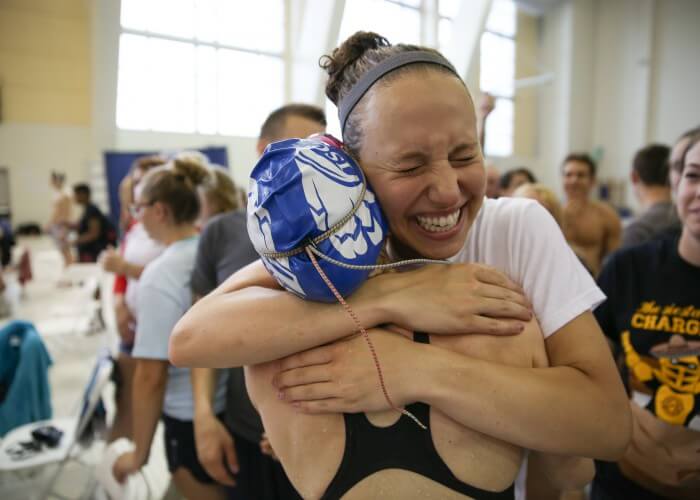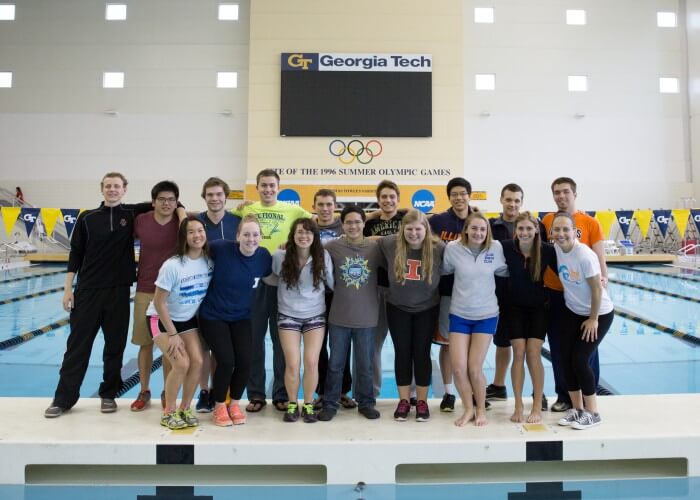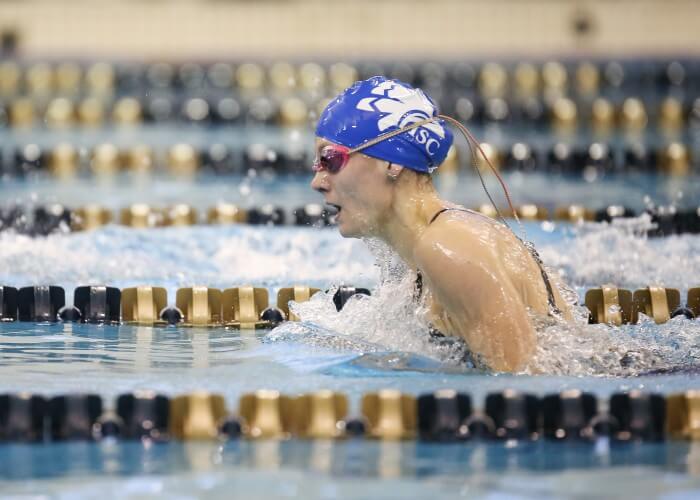Collegiate Club Swimming: The Path Less Traveled

By Kaylie Noll, Swimming World College Intern
In the swimming world, like other sports, there are many paths to consider after graduating from high school. When deciding to continue swimming, many people look toward competing at the collegiate level. Other athletes decide that it is time to hang up their suits and goggles for good. It seems like a fairly simple choice: either be a college athlete or retire and focus on other things in life such as school, family, or a career.
But what many swimmers don’t stop to think about is that there is a third option in their midst. That option is collegiate club swimming.
According to USA Swimming, collegiate clubs are teams usually organized by students that compete against other universities, unlike intramurals, which compete against participants from the same school. Additionally, most club sports have a national championship which student-athletes can attend, which creates a more intense atmosphere than simply joining intramural teams.
To really understand collegiate club swimming, it’s best to go to the source to find reliable, need-to-know information about club swimming in college.
Student-athletes Charlie Cain, Frankie Granata, and Jake Hamill from the University of Illinois-Urbana-Champaign along with Sam Schendorf from the University of Missouri dive into the task of answering seven questions about their lifestyle to clarify what it’s all about…
1. What kind of background do you need in order to swim club in college?
Cain:
Most of the people on our college club team swam in high school, but not necessarily all of us were on varsity then. However, you have to be good enough to pass tryouts, which entails being able to do certain events on certain times.
Granata:
I would say you would need at least four to six years of competitive swimming under your belt in order to even be considered to swim on a college club team.
Hamill:
While you don’t need to be amazing, you need more background than people might expect. Someone who has never swam competitively before, or even someone who has swam competitively, but only for one or two years, would not have the experience necessary to be on the club team. This is not because we only want fast people, but simply because they wouldn’t be able to do the things we do at practice. Our practices assume strong competency, which in swimming usually takes years to achieve.
Schendorf:
We don’t require any kind of swimming background. Most of us swam competitively from a young age, but we have a couple people that have never swam before.
2. What is the training like on your college club team?
Cain:
Practices are harder than I thought they would be. We practice four times a week, for an hour and a half. We have to lift and occasionally swim on our own, but only as much as we choose to.
Granata:
Training is what you make of it. Since we do not have an assigned coach, you dictate what you want to do or not want to do at every practice. If you wish to be challenged, you will be. But if you want to take it easy one day, no one will stop you. We push each other but understand that we aren’t in a scholarship commitment at the same time.
Hamill:
Most club teams don’t have a coach, so students create the workouts. On our team, we have an elected male and female captain who will write the workouts. These usually accommodate people of various skill levels.
Schendorf:
The training is what you make it. We don’t have a coach so our competition chair writes the practices for us. We break it up into three levels so you can have a practice that is as hard or as easy as you want it to be. Mizzou gives us pool time four days a week for official practice, but a lot of us get together on off days and swim together.
3. What are the competitions like at the collegiate club swimming level?

Photo Courtesy: Brenton Tse
Cain:
The meets are huge. For instance, our Nationals meet was held at Georgia Tech this year. There were 500-600 swimmers there. There are prelims and finals, and there are really fast times that can come out of there. Some people there are previous Division I swimmers that have already completed their four scholarship years. It’s still fun.
Granata:
The competitions are usually large and involve at least 10 teams from around the country or region. That being said, they are very long, but are taken very seriously.
Hamill:
For competitions, we will travel to another school, with the exception of our one home meet, and participate in a meet that usually takes several hours. Some teams will also host a party that night, as many attending teams will spend the night and drive home the next day.
Schendorf:
The meets are run like invites in high school. We don’t do dual meets too often, so usually there are several teams there. The smallest meet we’ve gone to was about four teams, and the biggest outside of Nationals is probably the one we host with about 300 swimmers. Nationals are in April in Atlanta and have over 1,200 athletes who compete in swimming and diving.
4. Are there any advantages to collegiate club swimming as compared to competing at the varsity level?
Cain:
There is a lot more free time for classwork, being on a club college team, rather than being fully committed to a scholarship program. You never get burnt out because it’s mainly about having fun. Also, you get to maintain swimmer shape and appetite.
Granata:
Being on a college club team gives you the satisfaction of being an athlete that represents your school, while not having the strenuous commitment that comes along with being a NCAA athlete. We also get private pool time and the opportunity to workout in a structured environment with athletes that love the sport. We form deep friendships with these people that are sure to last a lifetime.
Hamill:
The biggest advantages are that you get an instant group of friends, the opportunity to continue competing in a sport you love, and a way of staying in shape in college.
Schendorf:
The social aspect of it is definitely an advantage. I’ve met some of my best friends through the team and I wouldn’t have ever gotten to know them without it. Outside of the social part of it, it kept me grounded freshmen year when we all have a bit of a culture shock being on our own. The upperclassmen were awesome about making sure we were all okay and adjusting well to college and they were always there to talk to if we needed them.
5. How connected is the team outside of practice?

Photo Courtesy: Brenton Tse
Cain:
We go out together, get lunch, and have group messages. We also went on spring break together, and made it like a training trip. Your social status isn’t affected by how fast you are, like it could be in high school.
Granata:
Outside of practice, our team is extremely close. We use social media like Facebook and the app called Groupme often. Due to our social committee, of which I am the chair, the team has the opportunity to connect and visit at events and gatherings at least twice a month.
Hamill:
Our team is pretty close. We have team parties and we hang out on a fairly regular basis. Many of us have met some of our best college friends through the club.
Schendorf:
We try to stay really connected and get to know everyone. We have a lot of socials and we all hang out all the time, so it very quickly becomes a “school family” for people.
So What Is It All About?
Overall, collegiate club swimming is all about maintaining the identity of “swimmer” without committing to all the pressures and demands that a varsity team requires. It is a way to remain competitive, stay in shape, and avoid becoming a “swammer” by doing the sport you love, even if you aren’t ready or able to race at the varsity level.
In the case of the University of Illinois-Urbana-Champaign, as well as many others, there is only the option to swim at the collegiate level if you are a female. This means that joining the co-ed club team is the best route to take for males that strive to attend their dream university as well as continue swimming.
If you think collegiate club swimming is a potential route for you to take, USA Swimming provides a list of 150 schools that offer swimming as a club sport. Wherever your swimming journey takes you, there is a path for everyone.




